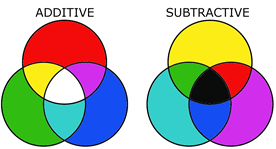Metallus
Hazard to Others
  
Posts: 116
Registered: 16-5-2013
Member Is Offline
Mood: No Mood
|
|
How does whitening/bluing work? (color schemes)
I have always had perplexities regarding the whitening/bluing action of some chemicals in the washing of clothes.
In practice, a blue/azure dye is added to your dirty white clothes, where the dirt is on average "yellowish", in order to give out the optical
illusion of white because blue and yellow are complementary colors... but that would work in an additive color scheme.
In fact, as far as I know, the RGB color model (additive) applies when talking about colored lights: in that case, mixing a yellow light (which is
actually the mix of red and green light) and blue light would give out white, because you are mixing all the colors.
However, the color mixing we are more used to is the substractive one, where the primal colors are yellow, cyan and magenta, and where the more you
mix colors, the darker is the result. In this case, mixing yellow dye with blue dye (which is actually the result of an object absorbing cyan and
magenta), would give out black, because you are mixing all the colors.
Below the two color models as reference:

Moreover, in the traditional RYB model, the complementary of blue would be orange and the mixing of yellow and blue would intuitively give out green,
whereas in the modern color scheme, it's the mixing of yellow and cyan that would give out green.
In the case of washing clothes and adding dyes, we are in the 2nd case, since those dyes do not emit light but rather reflect/scatter it.
TL;DR
How does a whitener/bluer exactly work, since the mixing of a cyan/blue and yellow dye should give respectively a green/black instead of white, in a
substractive color scheme?
Thanks for your attention
EDIT: I cleared out the 2nd point on my own by reading, but I still haven't understood the first.
[Edited on 19-1-2016 by Metallus]
|
|
|
Etaoin Shrdlu
National Hazard
   
Posts: 724
Registered: 25-12-2013
Location: Wisconsin
Member Is Offline
Mood: Insufferable
|
|
You're quite right that a mixture of blue with yellow produces "black." But, the yellow is very faint to start with, and the blue is very faint also,
which means that actually you wind up with a very faint gray.
There are also fluorescent brighteners which work through fluorescence and actually do brighten.
|
|
|
|